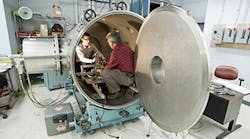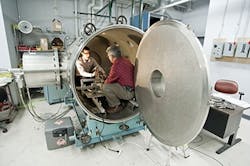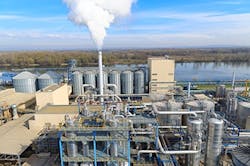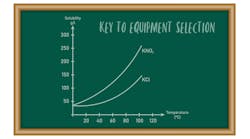Major research initiatives underway in the United States and European Union (EU) are striving to better understand industrial drying and to address the technical and economic issues posed by such operations.
Speaking in July 2016 at the opening of the Center for Advanced Research in Drying (CARD), based at Worcester Polytechnic Institute (WPI), Worcester, Mass., its director, WPI professor Jamal Yagoobi, pointed out that industrial drying processes waste about 2% of the 100 quadrillion BTUs (or quads) of energy used each year in the United States.
“If CARD achieves its aim of improving the energy efficiency of those processes by 10%, it could save 0.2 quads of energy each year. Also, since steam is the prime media used in industrial heating and drying, by making drying more efficient, the Center also aims to help reduce annual water usage in the U.S. by about 10 billion kilograms,” he added.
CARD received its initial funding though the National Science Foundation’s Industry/University Cooperative Research Centers program; it brings together researchers from WPI and the University of Illinois at Urbana-Champaign (UIUC) to tackle drying issues facing its industrial members.
“We have four main goals: to save member companies money by improving their energy efficiency; to help them meet sustainability goals; to improve their products and throughput; and to develop the skills of our students as their next generation workforce,” notes CARD program manager Mark Lippi.
Figure 1. Center for Advanced Research in Drying focuses on three critical aspects of drying. Source: Worcester Polytechnic Institute/CARD.
The center (Figure 1) is targeting manufacturing sectors that rely on energy-intensive drying processes such as: chemicals, pharmaceuticals and textiles; food and agriculture products; and forestry products such as paper, tissue and wood. The membership already includes Flint Hills Resources, Hershey’s, Kimberly-Clark, Ingredion, Massachusetts Clean Energy Center, Mondelez International and PepsiCo, among others. Each pays $50,000/yr for membership.
“While the details are confidential, we basically have three buckets of projects: new/novel drying technologies, sensor technologies — because it’s very important to be able to follow material changes through the drying process — and understanding the structural fundamentals of difficult-to-process materials,” he explains.
The universities and industrial partners jointly set research priorities at two annual meetings.
“We really only got started in February 2017 and we decided on 11 projects in our first year,” says Lippi.
Six, deemed sufficiently important, were rolled over into the 2018 quota of 12 projects. These projects focus on sensor development, novel impinging jet nozzles, and basic understanding of structural mechanisms of products. For example, WPI is taking the lead on: enhancement of heat and mass transfer with innovative jet nozzles; fundamental understanding of rapid air drying of paper tissues; and enhancement of municipal wastewater biosolids drying by changing interfacial energy to promote uniform aggregation. UIUC is heading efforts on: a wireless passive micro-electromechanical sensor for in-situ measurements of trapped moisture and pressure; and ultrasonic non-thermal drying of wet biopolymeric materials.
“I’m a bit disappointed about the five that were dropped, but that’s a function of how this program works — our industry members decide which projects to fund,” notes Lippi.
He believes that the most exciting developments will come from CARD’s work on sensors and novel drying technologies.
Both universities have long experience in sensor development and are uniquely positioned to do this kind of work, he stresses.
One initiative to watch here is the development of optical non-destructive testing (ONDT) sensors with extremely fine resolutions. These can detect changes in surface shape and texture as well as volumetric changes to different media during and after the drying process. Such ONDT sensors promise extremely accurate real-time monitoring and control of drying processes.
Among efforts to improve the drying operation itself, CARD researchers are applying ultrasound to dewatering. “In some industries, for example tissue paper manufacturing, the moisture content of the final product can sometimes be below 1%. We believe ultrasound will help to unbind and transfer water out of the material, making the drying process more efficient. The program is essentially focused on fluid transfer issues in different materials, so anything that improves the transport of fluids out of a material is of interest to us,” he adds.
Lippi is excited about the progress made to date. However, he would like to get members from additional industry sectors. This would open up a broader palette of projects and provide more funding so that ideas currently on hold can proceed.
“We are targeting chemicals and pharmaceutical companies,” he notes. While the main priority for industrial members is to access the research and keep up with new developments in drying, he believes that having access to a pool of skilled students and possible future employees who understand their drying processes is a significant lure, too.
Focus On Heat Pumps
Meanwhile in Europe, the DryFiciency Waste Heat Recovery in Industrial Drying Processes project represents one of the main research efforts.
The key goal of DryFiciency is to develop cost-efficient high-temperature industrial heat pumps that will enable energy-intensive industries to recover and use waste heat. The target is to reduce by 60–80% the energy used in drying and other dehydration processes.
Funding for the four-year project, which began in September 2016, comes from the EU’s Horizon 20/20 research program, €4.9 million (≈$5.7 million), and industrial partners involved in the work, €1.1 million (≈$1.3 million).
At the heart of the project are three high-temperature (up to 180°C) vapor compression heat pumps — two closed loop for air drying and the other open loop for steam drying.
The air drying work focuses on two applications. The first centers on the rotary dryers, spray dryers and flow stream dryers commonly used by the plastics, food, petrochemical and paper industries to dry their powder materials. The second concentrates on the tunnel and chamber dryers typical of bulkier materials created by the food and forestry industries.
The steam drying part of the project focuses on the superheated steam (SHS) dryers and chamber/belt dryers often used for bulkier products manufactured by the petrochemical, paper and food industries.
Three of the industrial partners — starch manufacturer Agrana Starke, Vienna; building materials supplier Wienerberger, Vienna; and consumer products and packaged food specialist Mars, Verden, Germany — then will validate the heat pumps.
“The technology we are developing is designed to be totally transferrable to the chemical industry and to other energy-intensive industries,” notes Veronika Wilk, scientific coordinator of the DryFiciency project and a scientist with the Austrian Institute of Technology (AIT), Vienna, which is coordinating the work.
“We already had relationships with Agrana and Wienerberger from an earlier energy management project we had already carried out with them. This allowed us to carry out calculations about how heat pump technology could benefit them. So we had two interested parties to start with and an in-depth knowledge of their processes so that we knew where the closed heat pump technology could be applied,” she adds.
Another project partner, Norwegian research organization SINTEF, Trondheim, is leading the development of the open-loop heat pump technology. SINTEF is working with industrial compressor specialist Rotrex, Ishøj, Denmark, and EPCON Evaporation Technology, Trondheim, a specialist in mechanical vapor recompression.
The first two phases of the project focused on developing key components such as compressors, bearings and lubricants, and on the development and design of the heat pump packages. The 18-month-long third phase, slated to start next March, involves demonstration plant work such as planning, design and construction, commissioning and test runs and, finally, validation of energy savings.
“We are really between phases two and three now and have just placed the tender for the heat pumps. They will be available at the demo sites at the start of next year with startup expected to occur in April or May,” says Wilk.
Getting to this point required overcoming some challenges, particularly for the closed-loop technology. Here, refrigerant gases, lubricants and seals posed problems because the DryFiciency heat pumps will operate at 160°C, which is 70°C higher than most standard heat pumps.
In the case of the seals, issues included swelling, changes in hardness and decomposition. Refrigerant experts Chemours, Neu-Isenburg, Germany, and Bitzer Kühlmaschinenbau, Sindelfingen, Germany, finally arrived at a suitable — although unnamed — material.
Chemours also developed the refrigerant for the high-temperature heat pump — Opteon MZ, a hydrofluoro-olefin with low global warming potential. Fuchs Schmierstoffe, Mannheim, Germany, developed the lubricant for the compressors.
Figure 2. Agrana plant in Pischelsdorf, Austria, will integrate a heat pump in its starch drying process. Source: APA-PictureDesk/Agrana/Schedl.
“We had to ensure that the compressor has adequate viscosity and that the media used are stable at high temperatures — to avoid acid formation as a result of degradation, for example. Now we have a system we are satisfied with,” explains Wilk.
She believes the main challenge for the industrial partners involved in the demonstrations next year is integrating the heat pump technology into their own processes: “We have designed the integration infrastructure in such a way that will allow the heat pumps to be stopped if there are any issues, but in such a way that the overall processes themselves won’t be interrupted — which is very important. If the heat pumps operate as expected, the companies will save energy and money.”
One of the closed-loop heat pumps will get tied into the continuous starch drying process at Agrana’s facility in Pischelsdorf, Austria (Figure 2).
That drying process requires hot air at 158°C. Currently, two heat exchangers preheat the air. The first uses hot water from a waste-heat recovery cycle, while the second relies on steam to get the air to the desired final temperature.
A third heat exchanger supplied by the heat pump will be integrated between these two and also will use waste heat from the heat recovery cycle as its heat source.
The heat pump demonstrator will have a heating capacity of around 400 kW, which is about 10% of the heat demand of the dryer, with temperatures up to 160°C. If all goes according to plan, the heat pump will decrease Agrana’s energy consumption by 2,200 MWh/yr and its carbon dioxide emissions by 500 m.t./yr.
The second closed-loop heat pump will get integrated with the tunnel dryer at Wienerberger’s plant in Uttendorf, Austria. That continuous dryer uses a counter-current flow of hot air to decrease the moisture content of shaped clay bricks from around 30% to 2–4%, which is the maximum moisture allowed in the firing process in the kiln. Surfaces located inside the tunnel receive hot water from a heat recovery cycle to heat the air.
Here, the heat pump also will use the heat recovery cycle as its heat source and provide hot water up to 160°C to heat the drying air. The hot air will go into the tunnel dryer’s outlet zone, which requires the highest temperatures. The heat pump will act as a booster for the heat recovery cycle.
This demonstration unit also will boast a heating capacity of around 400 kW. If all goes well on this project, the heat pump will cut energy consumption (natural gas) by 84% and reduce carbon dioxide emissions by about 79%.
At Mars’ Verden plant, the open-loop heat pump will serve a SHS dryer used on a pet food manufacturing line. The aim is for the heat pump demonstrator to fully substitute for the initial natural-gas heating system, reducing the specific energy consumption of the existing system from 800–900 kWh/m.t. of removed water to 200 kWh/m.t.
“The heat pump packages will arrive in standard cargo containers and be placed in locations where access and maintenance is easy because a lot of extra monitoring and control equipment will be used to measure pressures and temperatures at many points in the heat pump and also to allow refrigerant and lubricant samples to be taken on a regular basis. Both closed-loop heat pumps will also be monitored online from the AIT with SINTEF monitoring the open-loop one,” notes Wilk.
The demonstrations will run until the end of the project in August 2020 and possibly beyond that if all goes well. Once the heat pumps are up and running, AIT will stage a series of events at which people can meet with the industry partners involved to discuss the technology.





